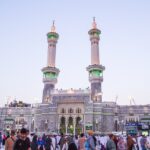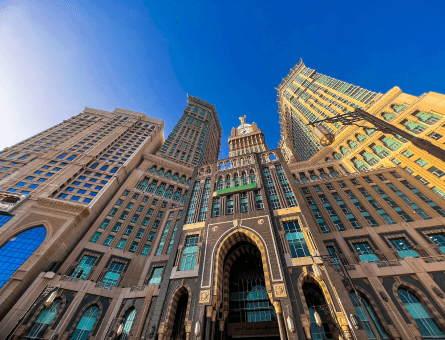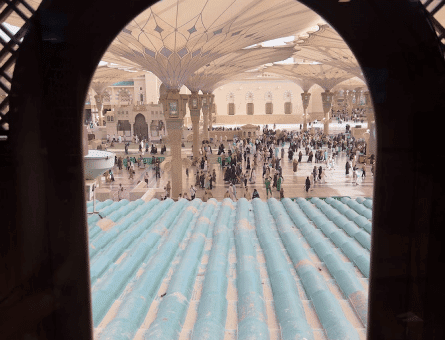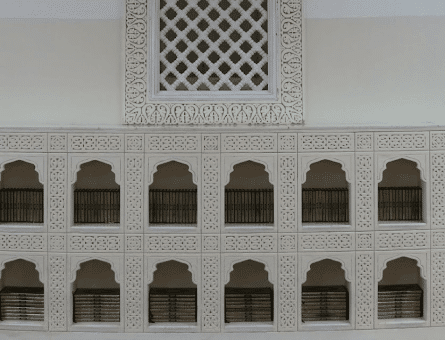Jamarat – Stoning of the Devil – 3 Stone pillars
The three-stone wall pillars situated in the tent city of Makkah, Saudi Arabia, are known as the Jamarat. They hold significant value in Islam because while performing Hajj, it is a compulsory ritual for pilgrims to pelt the Jamarat in emulation of Prophet Ibrahim’s (AS) devotion to the command of Allah SWT.
The three pillars (Jamarah al-‘Ula, Jamarah al-Wusta, and Jamarah al-Kubra [also knonwn as al-‘Aqabah]) represent the locations where Prophet Ibrahim (AS) pelted Satan (Shaitan) with stones when Satan tried to dissuade him from sacrificing his son, Prophet Ismail (AS) in the way of Allah (SWT). Keep reading to learn more about the Jamarat.
What Is the Jamarat?
The Jamarat are the three stone pillars located in Mina, within the boundaries of Makkah, Saudi Arabia. Hajj pilgrims pelt these pillars to commemorate the event when a 94-year-old father, Prophet Ibrahim (AS), was ready to sacrifice his 8-year-old son Prophet Ismail (AS) on the command of Allah SWT.
Each of the Jamarah symbolise an important sacrifice. The first Jamarah marks the temptation of Prophet Ibrahim (AS) to not sacrifice his son following the command of Allah SWT. The second Jamarah represents the temptation of Hajrah (AS), the mother of Prophet Ismail (AS) and the second wife of Prophet Ibrahim (AS), against the sacrifice.
Lastly, the third Jamarah represents the temptation of Prophet Ismail (AS) against being sacrificed. Regardless of how much he tried, Shaitan failed in all three instances.
The significance of the ritual can be understood from the following narration of Abdullah Ibn Abbas:
“The Prophet (PBUH) seated al-Fadl behind him on his mount, and al-Fadl said that he did not stop reciting the Talbiyah until he stoned the Jamrah.” (Al-Bukhari: 1685 and Muslim: 1282)
Abdullah, in another instance, narrates: “He came to the largest Jamrah and kept the House (i.e., the Kaaba) on his left and Mina on his right and stoned it (i.e., the Jamrah) with seven (pebbles), and he said: This is how the one to whom Surah Baqarah was revealed (blessings and peace of Allah be upon him) stoned it.” (Al-Bukhari: 1748 and Muslim: 1296)
What Does Jamarat Mean?
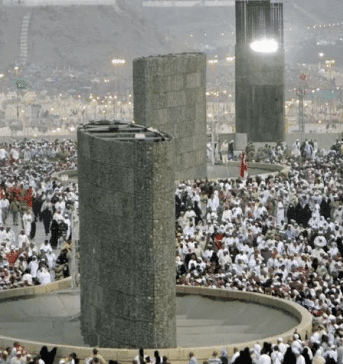
Jamarat is the plural for the Arabic word “Jamrah,” which literally means a small piece of a pebble or stone. However, here the term Jamarat represents each of the stone pillars involved in the ritual of Rami, i.e., stoning the devil.
Why Do Muslims Throw Stones at the Jamarat?
When a Muslim performs the ritual of stoning the Jamarat, it is not the pillars that they attack but rather the tricks of Satan (Shaitan) and one’s inner evil. The act gives Muslims the strength to dissociate themselves from Satan’s path, whispers, and effects and helps them replace it with the remembrance of Prophet Muhammad (PBUH) and faith in Allah SWT.
While pelting the Jamarat, a pilgrim makes a firm resolution not to go back to the sins they used to commit, no matter how big or small, and to do whatever it takes to become a better Muslim.
Jamarat during Hajj
The incident of Prophet Ibrahim (AS) throwing stones at Satan (Shaitan) is given permanence in the lives of Muslims by making it a compulsory ritual of Hajj and Umrah. It is otherwise known as the stoning of the Jamarat which is performed on the 10th, 11th and the 12th Dhul Hijjah (note: if one remains in Mina on the 13th, then it is necessary to stone the Jamarat on the 13th of Dhu al-Hijjah aswell). This is when after arriving from Muzdalifah, Muslims spend the night in Muzdalifah, on the 9th of Dhu al-Hijjah, and collecting at least seventy (70) stones with the intention to pelt the pillars of Jamarat starting on the next day in Mina.
“Of the 70 stones, seven are for the 10th of Dhul Hijjah, twenty-one for the 11th and twenty-one for the 12th. An extra twenty-one are picked as a precautionary measure”
The ritual of Rami not only symbolises the expulsion of evil worldly thoughts and Satan (Shaitan), it also serves as a lesson by giving pilgrims the strength to protect themselves from evil every day.
The History of Jamarat
The ritual of the stoning of the Jamarat serves as a symbol of the incident between Satan (Shaitan) and Prophet Ibrahim (AS). While he was en route to fulfil the commandment of Allah SWT, Satan (Shaitan) tried to discourage Prophet Ibrahim (AS) from following the orders of Allah SWT, over and over multiple times. That is when Angel Jibraeel (AS) miraculously showed up and instructed Prophet Ibrahim (AS) to cast pebbles at Satan (Shaitan). Al-Azraqi (a Muslim historian), while explaining the famous incident, said:
“When he [Ibrahim] left Mina and was brought down to al-Aqaba, the Devil appeared to him at the site of the first Jamrah (i.e., al-‘Aqabah). Gabriel (Jibril) said to him: “Pelt him!” so Ibrahim threw seven stones at him so that he disappeared from him. Then he appeared to him at the site of the second Jamrah. Gabriel said to him: “Pelt him!” so he pelted him with seven stones so that he disappeared from him. Then he appeared to him at the site of the third Jamrah. Gabriel said to him: “Pelt him!” so he pelted him with seven stones similar to pebbles used to fire from a sling. So, the Devil withdrew from him.”
When picking stones for Jamarat, the pebbles should ideally be the size of a pea although there is no compulsion
Jamarat Pillar Names
The three pillars of Jamarat in Makkah are named in order to explain the strength with which Satan (Shaitan) tried to dissuade Prophet Ibrahim (AS) from completing the sacrifice of his beloved son. Here is everything you need to know about the three pillars:
Jamrah Sughra or Jamrah al-Ula
It is the smallest Jamrah and the first pillar. It is at the greatest distance from the point of sacrifice, and it is believed that Satan (Shaitan) tried his least efforts here. Jamarat Sughra is also nearest to Masjid Al-Khafy and farthest from Makkah.
Jamrah al-Wusta
Located between Jamrah al-Kubra and Jamrah al-Ula, Jamrah al-Wusta is the middle pillar. It was originally shaped like an obelisk. However, in AD 2004/1425 AH, it was transformed into a tall flat wall (for ease of pelting by masses).
Jamrah al-Kubra or Jamrah al-Aqabah
Although it is the largest, Jamarah-al-Kubra is situated nearest to the point where the sacrifice took place, and to Makkah. It is located on the mountainside of Mina and was reconstructed in AD 1956-1957/1376 AH to make more space for pilgrim to perform the ritual. Based on recent changes, Jamarah al-Aqabah comprises a 1-metre thick wall and is 25-metres long. It is the place where Satan (Shaitan) made the utmost effort to persuade Prophet Ibrahim (AS).
Jamarat Bridge
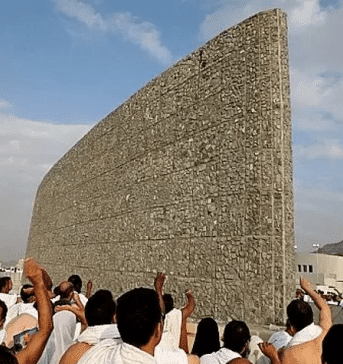
Constructed by the Saudi government, the Jamarat Bridge is a pedestrian bridge that connects all three Jamarat. This bridge is widely used by pilgrims while performing the ritual of Rami during Hajj. The primary purpose of the bridge is to allow pilgrims to safely throw stones at the three Jamarat pillars, either from the bridge’s height or from ground level.
Since its development in 1963, the Jamarat Bridge has been expanded and reconstructed several times. Today, the bridge has three openings and is strong enough to hold more than a million pilgrims at once.
Summary – Jamarat
The Jamarat are the three stone pillars located in Mina. These stone structures represent the locations of Satan (Shaitan), where he repeatedly attempted to discourage Prophet Ibrahim (AS) from carrying out Allah’s (SWT) command to sacrifice his eldest son, Prophet Ismail (AS).
Stoning the three Jamarat: Jamarat al-Ula, Jamarat al-Wusta, and Jamarat al-Aqaba – also known as Rami, is one of the main rituals of Hajj and Umrah. Every year, millions of Muslims come together to pelt the three pillars with the intention to commemorate the actions of Prophet Ibrahim (AS) and fight the evils of their soul, be it greed, pride, anger, ego etc. Hajj is incomplete without performing the act of Rami.
Explore The New Pilgrim App
The Ultimate App
for Hajj and Umrah!







